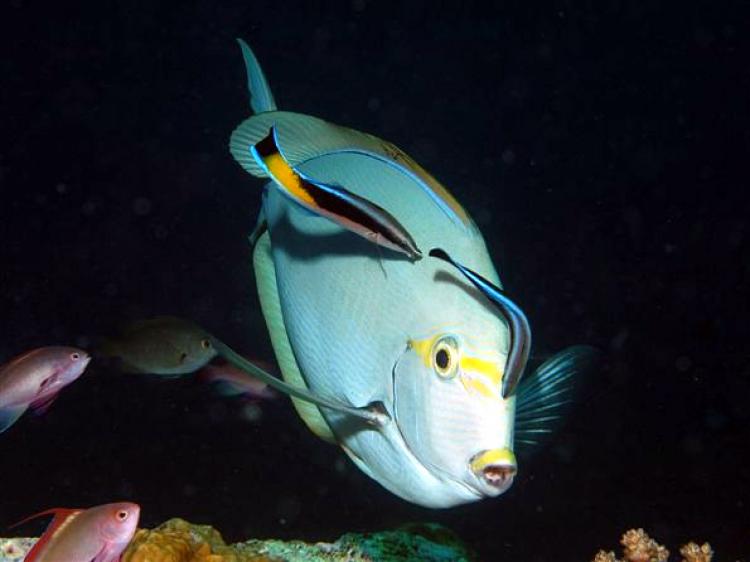For several years, researchers at the Universities of Neuchâtel in Switzerland and Queensland in Australia have been working to uncover the mystery of a peculiar little fish, Labroides dimidiatus, commonly known as the bluestreak cleaner wrasse. This little fish is known in the seas for taking good care of larger predatory fish and is therefore protected. Predator fish recognize the community service rendered by the little wrasses and refrain from eating them.
Bluestreak cleaner wrasses are found in tropical coral reefs. They are sequential hermaphrodites. They are born as females and often live in small groups with only one male. When the male in a group dies, the most dominant female in the group will transform into a male.
Measuring just under four inches, the little wrasse does not hesitate to throw itself down the throat of a shark or moray eel, where it provides dental and massage services by eating parasites and algae that grow on the bigger fish.
Wrasses are easily recognized by their luminescent blue stripe and distinct, jerky swimming. They remove parasites from larger reef fish at so-called cleaning stations. Their clients place themselves in the specified treatment locations and assume a stiffened “ready” position, with their bodies tilted slightly backward and mouths wide open, until the wrasses finish cleaning.
Wrasses eat parasites lodged in unprotected crevices without scales (like the mouth, gills, and fins). These parasites bother the predator fish, which are unable to remove them and thus are appreciative of the wrasses’ services. Wrasses also calm their clients by caressing their fins to induce a sense of well-being and relaxation.
In coral reefs, wrasses provide cleaning service to two kinds of clients: resident fish that stay close by, and occasionals that come to the area solely for cleaning. The occasionals are more demanding as they like to select their cleaner wrasse, and demand not to be bitten.
A particularity of the wrasse, observed by Dr. Redouan Bshary, professor of behavioral ecology at Neuchâtel University and colleagues and published in the journal Science, is that the male wrasses punish females that bite their clients. Females like to nip a little savory mucus, but the predator fish do not like being bitten and will not return once they are chomped on. Male wrasses have been observed disciplining females when they bite their clients, seemingly to keep the clients happy and their source of food stable.
To understand this behavior, Bshary and colleagues devised an experiment in which they offered fish flakes and prawns to a pair of wrasses. The wrasses clearly preferred to eat the prawns. Then, when the wrasses ate a prawn, the researchers removed all food from the aquarium. They observed that male wrasses would then become aggressive toward females when they tried to eat the prawns. As the experiment continued, the females began to refuse to eat the prawns.
The abstract of the research paper is available at sciencemag.org .
Bluestreak cleaner wrasses are found in tropical coral reefs. They are sequential hermaphrodites. They are born as females and often live in small groups with only one male. When the male in a group dies, the most dominant female in the group will transform into a male.
Measuring just under four inches, the little wrasse does not hesitate to throw itself down the throat of a shark or moray eel, where it provides dental and massage services by eating parasites and algae that grow on the bigger fish.
Wrasses are easily recognized by their luminescent blue stripe and distinct, jerky swimming. They remove parasites from larger reef fish at so-called cleaning stations. Their clients place themselves in the specified treatment locations and assume a stiffened “ready” position, with their bodies tilted slightly backward and mouths wide open, until the wrasses finish cleaning.
Wrasses eat parasites lodged in unprotected crevices without scales (like the mouth, gills, and fins). These parasites bother the predator fish, which are unable to remove them and thus are appreciative of the wrasses’ services. Wrasses also calm their clients by caressing their fins to induce a sense of well-being and relaxation.
In coral reefs, wrasses provide cleaning service to two kinds of clients: resident fish that stay close by, and occasionals that come to the area solely for cleaning. The occasionals are more demanding as they like to select their cleaner wrasse, and demand not to be bitten.
A particularity of the wrasse, observed by Dr. Redouan Bshary, professor of behavioral ecology at Neuchâtel University and colleagues and published in the journal Science, is that the male wrasses punish females that bite their clients. Females like to nip a little savory mucus, but the predator fish do not like being bitten and will not return once they are chomped on. Male wrasses have been observed disciplining females when they bite their clients, seemingly to keep the clients happy and their source of food stable.
To understand this behavior, Bshary and colleagues devised an experiment in which they offered fish flakes and prawns to a pair of wrasses. The wrasses clearly preferred to eat the prawns. Then, when the wrasses ate a prawn, the researchers removed all food from the aquarium. They observed that male wrasses would then become aggressive toward females when they tried to eat the prawns. As the experiment continued, the females began to refuse to eat the prawns.
The abstract of the research paper is available at sciencemag.org .






